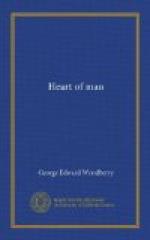This element of self finds its intense expression in lyrical love-poetry, one of the most enduring forms of literature because of its elementariness and universality; but it is also found in other parts of the emotional field. In seeking concrete material for lyrical use the poet may take some autobiographical incident, but commonly the world of inanimate nature yields the most plastic mould. It is a marvellous victory of the spirit over matter when it takes the stars of heaven and the flowers of earth and makes them utter forth its speech, less as it seems in words of human language than in the pictured hieroglyph and symphonic movement of natural things; for in such poetry it is not the vision of nature, however beautiful, that holds attention; it is the colour, form, and music of things externalizing, visualizing the inward mood, emotion, or passion of the singer. Nature is emptied of her contents to become the pure inhabitancy of one human soul. The poet’s method is that of life itself, which is first awakened by the beauty without to thought and feeling; he expresses the state evoked by that beauty and absorbing it. He identifies himself with the objects before him through his joy in them, and entering there makes nature translucent with his own spirit.
Shelley’s Ode to the West Wind is the eminent example of such magical power. The three vast elements, earth, air, and water, are first brought into a union through their connection with the west wind; and, the wind still being the controlling centre of imagination, the poet, drawing all this limitless and majestic imagery with him, by gradual and spontaneous approaches identifies himself at the climax of feeling with the object of his invocation,—




